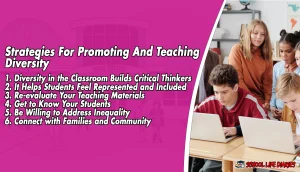In today’s increasingly interconnected world, classrooms have become microcosms of diverse cultures, backgrounds, and perspectives. Embracing and celebrating diversity in the classroom is not just a matter of social justice, but it also holds immense educational value.
It enriches the learning experience, fosters empathy and understanding, and prepares students for the global society they will navigate in the future. By creating inclusive spaces where every voice is heard and respected, educators can cultivate an environment that promotes learning, collaboration, and personal growth.
In this blog post, we will explore the significance of diversity in the classroom and delve into the many benefits it offers to students and educators alike. Let us embark on this journey of discovery, as we uncover the power of diversity in shaping the minds and hearts of our future generations.
What Is Diversity In The Classroom?
Diversity in the classroom refers to the presence of students from various cultural, ethnic, linguistic, socioeconomic, and ability backgrounds within a learning environment. It encompasses differences in race, religion, gender, sexual orientation, nationality, and more.
A diverse classroom represents the rich tapestry of society, where students bring their unique perspectives, experiences, and talents. It goes beyond mere representation; it is about creating an inclusive space where every student feels valued, respected, and able to contribute.
Embracing diversity in the classroom means recognizing and appreciating the unique strengths and challenges that each student brings, and fostering an environment that promotes equity, cultural understanding, and open dialogue. It is a powerful opportunity to prepare students for a diverse world, promoting empathy, critical thinking, and collaboration.
Why Is Diversity In The Classroom Important?
Diversity in the classroom holds immense importance for several reasons:
1. Enhances Learning:
A diverse classroom brings together students with different perspectives, backgrounds, and experiences. This diversity of ideas and viewpoints fosters intellectual growth and critical thinking. Students learn to see issues from multiple angles, challenge their own biases, and develop a broader understanding of the world.
2. Promotes Cultural Understanding:
Interacting with peers from diverse backgrounds promotes cultural understanding and appreciation. Students learn about different customs, traditions, languages, and belief systems, which helps break down stereotypes and fosters a sense of global citizenship.
3. Builds Empathy and Social Skills:
By engaging with classmates from diverse backgrounds, students develop empathy and social skills. They learn to listen, communicate, and collaborate effectively with people who have different perspectives and experiences. This helps prepare them for future interactions in a diverse and interconnected world.
4. Enhances Problem-Solving Abilities:
Diversity in the classroom encourages students to approach problems and challenges from different angles. When working on group projects or discussions, students benefit from diverse problem-solving strategies, creativity, and innovative thinking.
5. Prepares for the Real World:
In the real world, individuals interact with people from various backgrounds. By experiencing diversity in the classroom, students develop the skills needed to navigate diverse workplaces, communities, and global environments successfully.
6. Reduces Prejudice and Discrimination:
Exposure to diversity from an early age reduces prejudice and discrimination. Students learn to appreciate differences, challenge stereotypes, and treat others with respect and equality.
7. Enhances Academic Achievement:
Research has shown that diverse classrooms have positive impacts on academic achievement. Students in diverse learning environments tend to have higher academic performance, critical thinking skills, and problem-solving abilities.
Contribute To The Ongoing Effort To Diversify Education
In today’s increasingly interconnected and diverse world, the need for a more inclusive and diverse education system has never been greater. As we strive to create a society that celebrates and values the richness of different cultures, perspectives, and experiences, it is crucial to contribute to the ongoing effort to diversify education. By actively promoting diversity in education, we can ensure that every student has equal opportunities to learn, grow, and succeed.
One way to contribute to this effort is by advocating for inclusive curricula and teaching materials that reflect the diversity of our society. Encourage educators and educational institutions to incorporate diverse voices, histories, and perspectives into their lesson plans, textbooks, and classroom discussions. By doing so, we can provide students with a more comprehensive and accurate understanding of the world, fostering empathy, tolerance, and respect.
Supporting initiatives that promote access to education for underrepresented and marginalized groups is another impactful way to contribute to diversifying education. This can involve volunteering with organizations that provide educational opportunities to disadvantaged communities, advocating for equal educational opportunities for all students, or donating resources to support scholarships and programs that empower marginalized students.
Embracing diversity in the classroom also requires creating inclusive and welcoming environments where all students feel valued and respected. Educators and school administrators can implement policies and practices that promote inclusivity, such as establishing anti-bullying and anti-discrimination measures, providing cultural sensitivity training for staff, and creating safe spaces for open dialogue and appreciation of diversity.
Engaging in open and respectful conversations about diversity and inclusion within educational communities can foster awareness, understanding, and collaboration. By actively listening to different perspectives, sharing personal experiences, and challenging biases, we can create a culture of inclusivity that extends beyond the classroom walls.
Each of us has a role to play in diversifying education. Whether you are a student, parent, educator, or community member, your efforts can make a difference. By working together, we can create a more inclusive and equitable education system that empowers every student to thrive and contribute their unique talents and perspectives to the world.
Why A Diverse Teacher Workforce Matters?
A diverse teacher workforce is essential for creating a truly inclusive and equitable education system. While diversity in the classroom is crucial, the presence of a diverse group of teachers is equally important. Here are several reasons why a diverse teacher workforce matters:
1. Representation and Role Models:
Having teachers from diverse backgrounds provides students with role models who they can relate to and aspire to become. When students see teachers who share their cultural, racial, or ethnic background, it instills a sense of belonging, validates their identity, and expands their possibilities for success.
2. Cultural Competence and Understanding:
Diverse teachers bring unique perspectives, experiences, and cultural knowledge into the classroom. They can provide insights into different cultures, languages, and traditions, fostering cultural competence among students and promoting a broader understanding of the world.
3. Enhanced Learning Environment:
A diverse teacher workforce enriches the learning environment by exposing students to a variety of teaching styles, approaches, and perspectives. This diversity of teaching methods can cater to different learning needs and preferences, promoting more engaging and effective learning experiences for all students.
4. Breaking Stereotypes and Bias:
Diverse teachers challenge stereotypes and bias by defying narrow perceptions and showcasing the vast capabilities and talents of individuals from different backgrounds. They can help break down societal prejudices and promote acceptance, empathy, and respect among students.
5. Addressing Achievement Gaps:
Research has shown that students from underrepresented backgrounds often benefit from having teachers who share similar cultural or linguistic backgrounds. Diverse teachers can better understand and address the unique challenges and barriers faced by these students, helping to bridge the achievement gaps that exist in education.
6. Cultivating Global Citizenship:
In an increasingly globalized world, having a diverse teacher workforce prepares students to become global citizens. It exposes them to different perspectives, worldviews, and ways of thinking, fostering open-mindedness, appreciation for diversity, and the skills needed to navigate a multicultural society.
7. Creating Inclusive School Communities:
Diverse teachers play a crucial role in creating inclusive school communities where all students feel welcomed, respected, and valued. They can contribute to the development of inclusive policies, practices, and curricula that address the needs of diverse student populations and promote equal opportunities for success.
Strategies For Promoting And Teaching Diversity
Promoting and teaching diversity in the classroom is essential for fostering inclusivity, empathy, and a deeper understanding of the world. Here are strategies to effectively promote and teach diversity:
1. Diversity in the Classroom Builds Critical Thinkers:
Encourage critical thinking by presenting diverse perspectives, experiences, and voices. Engage students in discussions that challenge stereotypes and biases, fostering their ability to analyze and evaluate information from multiple viewpoints.
2. It Helps Students Feel Represented and Included:
Incorporate diverse literature, images, and examples in your teaching materials to ensure students from all backgrounds feel seen and valued. Use culturally relevant content that reflects the experiences of your students, promoting a sense of belonging and fostering engagement in the learning process.
3. Re-evaluate Your Teaching Materials:
Regularly review and update your teaching materials to ensure they are inclusive and representative. Avoid relying solely on one perspective or narrative, and seek out resources that showcase diverse cultures, histories, and contributions. This will provide a more comprehensive and accurate understanding of the world.
4. Get to Know Your Students:
Take the time to understand your students’ backgrounds, cultures, and experiences. Foster open and honest conversations, create a safe space for sharing, and encourage students to express their unique perspectives. This will deepen your connection with students and create a classroom environment that values diversity.
5. Be Willing to Address Inequality:
Recognize and address instances of inequality or bias that may arise in the classroom. Challenge stereotypes, prejudices, and discriminatory behaviors by promoting empathy, respect, and fairness. Teach students to be advocates for social justice and encourage them to take action against injustice.
6. Connect with Families and Community:
Involve families and the community in classroom activities and discussions related to diversity. Collaborate with parents, guardians, and community members to incorporate diverse perspectives and experiences into the curriculum. Engaging families and the community reinforces the importance of diversity in education.
Related Article: Conflicts In Schools Examples: Causes And Strategies
Conclusion:
Embracing diversity in the classroom is crucial for creating a rich and inclusive educational environment. By promoting and teaching diversity, we empower students to become critical thinkers, foster a sense of belonging, and address inequality.
Incorporating diverse perspectives, materials, and experiences allows students to feel represented and included, while also cultivating empathy and understanding. Re-evaluating teaching materials, getting to know students on a personal level, and actively addressing inequality are essential steps in promoting diversity.








